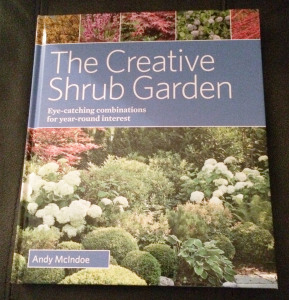The Creative Shrub Garden: Eye-catching combinations for year-round interest by Andy McIndoe, Timber Press, Portland, 2014, $29.95.
In the world of landscape design, shrubs are often selected for their structure. Andy McIndoe, author of The Creative Shrub Garden, believes that shrubs should, instead, be chosen for their foliage because the color, texture, and form of the leaves should be the heart of planting design. The author speaks from his experience of creating three different gardens as well as visiting gardens of all sizes and styles. While shrubs often dominate the middle layer of a landscape, they can also be used as the upper or lower layer.
McIndoe posits the thesis that shrubs provide four seasons of interest because of their permanence whereas most perennials go dormant during the winter. I would say, however, that many perennials provide structure during the winter as long as the notion of fall cleanup is spurned. What I do agree with is his thesis that a landscape can be composed solely of shrubs. As with any type of design, the focus then becomes the creation of combinations that achieve a particular mood or style.
Most homeowners today want low maintenance landscapes so the selection of these shrubs must be based on knowledge of mature size. Homeowners want color and interest all year round without spending much time pruning. The choices available now have increased geometrically within the past ten years and many more are coming. Many of the new hybrids rebloom, have colorful branches, and/or are disease resistant. Since McIndoe is an Englishman, some of the shrubs he mentions are not hardy in the Midwest but most of his choices are relevant to us.
With so many choices available, McIndoe suggests the factors that should be considered: the size of the garden (small or large?), the size of the planting area (should you widen the area to allow for groupings instead of linear planting?), the size of the shrub (will depend on growing conditions), the expected life of the shrub, the climate, the site (windy? amount of light?), and the soil type. Helpfully, McIndoe has lists of shrubs for particularly challenging growing situations such as heavy clay, wind, heavy shade, wet, and hot dry sites. He also reminds us that we need to select plants with varying peak seasons of interest so that the landscape isn’t beautiful only in the spring. If the shrub blooms, what does it look like when it’s not in bloom?
McIndoe reiterates design principles that are crucial in creating shrub combinations: color balance when using strongly colored plants, repetition to create rhythm and unity, massing to create drama, layering to create contrast, variety to create interest.
I was fascinated by McIndoe’s scheme for planting a large area that was formerly all turf. He would plant some trees and groupings of large shrubs in circular planting beds cut into the turf, thus creating structure. As these plants mature, complementary plants could be added. This scheme negates the necessity of doing everything at once; instead, it is done in phases.
I was particularly interested in the section on combining shrubs to create moods and styles. McIndoe always starts with three small to medium-size shrubs that work well together and suggests three additional shrubs that would combine well with them to create a larger planting. He also has ideas for larger background plants as well as some perennials, bulbs, or climbers for foreground areas. Immediately after this section is a plant directory composed of the plants that he has used in his combinations.The last section of the book focuses on planting and maintenance advice for shrubs in the ground or in containers.
McIndoe has an excellent eye and we can all benefit by examining his combinations and using them as a guide to creating our own.



0 Comments